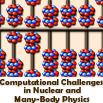Speaker
Thomas Duguet
Description
Ab initio many-body methods have been developed over the
past ten years to address closed-shell nuclei up to mass
$\text{A}\sim 130$ on the basis of realistic two- and
three-nucleon interactions. A current frontier relates to
the extension of those many-body methods to the description
of open-shell nuclei. Several routes are currently under
investigation to do so among which one relies on the
powerful concept of spontaneous symmetry breaking. Singly
open-shell nuclei can be efficiently described via the
breaking of U(1) gauge symmetry associated with
particle-number conservation, as a way to account for their
superfluid character. Doubly open-shell nuclei can be
addressed by further breaking SU(2) symmetry associated with
angular momentum conservation. Still, the description of
finite quantum systems eventually requires the exact
restoration of symmetry quantum numbers. In this context, we
discuss two recent developments performed within the frame
of single-reference coupled cluster theory. First, we
present the Bogoliubov coupled cluster formalism, which
consists of representing the exact ground-state wave
function of the system as the exponential of a
quasi-particle excitation cluster operator acting on a
Bogoliubov reference state. Test calculations for the
pairing Hamiltonian are presented along with realistic
proof-of-principle calculations of even-even nuclei with
$\text{A} \approx 20$. Second, we discuss a recent extension
of symmetry-unrestricted coupled-cluster theory that allows
for the exact restoration of the broken symmetry at any
truncation order. The formalism, which encompasses both
single-reference coupled cluster theory and projected
Hartree-Fock theory as particular cases, permits the
computation of usual sets of connected diagrams while
consistently incorporating static correlations through the
highly non-perturbative restoration of the symmetry. A key
difficulty relates to the necessity to handle generalized
energy {\it and} norm kernels for which naturally
terminating coupled-cluster expansions are indeed obtained.
The focus is on SU(2) and U(1) symmetries but the formalism
can be extended to any (locally) compact Lie group and to
discrete groups, such as most point groups.

